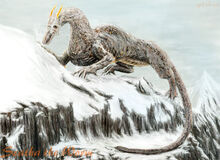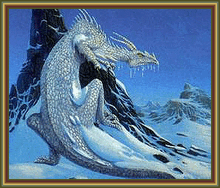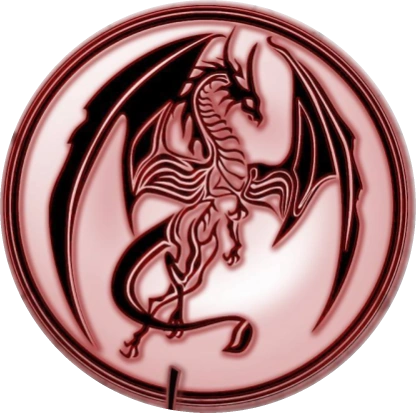Dragons were ancient, intelligent, powerful creatures, as feared by others as they were admired in Middle-earth. Their exact origin is debatable, though it was clearly stated that they were created by Morgoth in some sense. They were intelligent creatures that could speak the languages of men and elves alike, and they were likely immortal unless blade or poison took them.
Dragons lived throughout the First, Second, and Third Ages of Middle-earth and may have lived on for far longer. They were originally bred by Morgoth during the First Age to serve as gigantic shock troopers and mobile artillery. The first dragon ever seen in Middle-earth was Glaurung, the father of dragons, who Morgoth used to great effect during the fourth and fifth battles in the War of the Jewels. Like most of the creatures made or twisted by Morgoth, they were capable of reproducing naturally. Dragons were sometimes referred to as serpents, great Worms, or simply as Drakes, with the first two specifying the Wingless Dragons.
During the First Age, the greatest heirloom of the house of Hador was the Dragon-helm of Dor-lómin, which was a helm of great weight that had as its crest an image of the head of Glaurung the Dragon.
The dragons of the Second Age and Third Age were a blight upon the Dwarves and all those who hoarded treasure. Some, like Smaug the Golden and Scatha the Worm, went from the Withered Heath and invaded Dwarven kingdoms. Before the coming of Smaug, there had not been notable activities observed during the Second Age, but dragons seemingly kept serving as dark servants ( or partially at least).
There was an inn in The Shire called The Green Dragon named after the creatures, and a type of flower and firework called a Snap Dragon. For Bilbo Baggins' 111th birthday, Gandalf made a special dragon firework.
It is presumed that, after the death of Smaug in the Third Age, the great dragons had become extinct. According to Gandalf, the fire-drake race survived until at least just before the War of the Ring, and some lesser kin survived even after the war. It may have been possible that some races of dragon still existed throughout the Fourth Age.

Ancalagon the Black: Greatest of the winged Fire-Drakes.
There were two (possibly three) main types of dragon; the Fire-Drake, or Uruloki, which could breathe fire, and the Cold Drake, which did not utilize a breath weapon, though some were could breathe a vapor, smoke or mist. A third supposed breed, the Stone Dragons, were little-known and possibly nonexistent.
These types of dragons were further divided into winged and wingless variety. Either type could be winged or wingless, and some others still had no legs either. Regardless, winged dragons were the more likely to be Fire-Drakes, while many wingless dragons were Cold-Drakes. The legless variants, known as Wyrms or Long-worms, could also be of either type and were serpentine and deadly in their own right.
Dragons were long-lived, powerful, cunning, possessed of subtle intelligence, had great physical strength, and were covered in nearly impenetrable scales everywhere except their undersides. They also posessed an overwhelming greed for treasure, especially gold, and were well known for sleeping on piles of stolen treasure. By their very nature, they relished not only the theft of beautiful things, but the act of dispossession itself; essentially, it was more satisfying for them to steal treasure from another rather than come upon unclaimed valuables. According to Thorin Oakenshield they had a very keen sense of the value of their hoard, but never themselves crafted so much as a brass ring. Dragons were also prone to fits of anger, which could result in devastating effects upon the surrounding land and those living on it. The reasons behind their strong affinity for gold are unknown, but dragons often put a greater priority on possessing gold than on obtaining food, and they can survive not eating (and maybe drinking as well) for decades or perhaps centuries. This suggests that jewels may be primal sources of the great serpents' life forces (though they could also simply possess extremely slow metabolisms, similar to other reptiles but exaggerated). Due to this fact, dragons of Arda may or may not be immortal in ideal conditions, though regardless they are known to live for very long periods of time. Not much is known about the life cycle of dragons, but it is known that Glaurung, the progenitor of the species, took three centuries to grow from infancy to adulthood, and that he was considered an "adolescent" after growing for around a century. If Glaurung's development mirrors that of other dragons, then it also takes a great deal of time for their scales to become hard, as Glaurung's could still be penetrated by arrows after a century of development.

Smaug: Last of the Fire-Drakes of Middle-Earth.
Many accounts of interaction between dragons and other beings makes mention of them speaking, using the Common Tongue. In conjunction with this, they also possessed a hypnotic power known as the "dragon-spell", by which weaker-willed beings could be put into a trance or bent to a dragon's will when the beast spoke. Even those of strong will could be subjected to this ability, especially if they were not prepared for it. Glaurung in particular was the unparalleled master of this ability, as even strong-willed foes could fall victim to his gaze. Dragons could make even greater use of this ability through psychological manipulation, increasing the power of the spell by taunting a subject with knowledge of some inner conflict on the part of the subject. Glaurung, for instance, was not fully capable of bending Túrin to his will, but when the dragon began to taunt him with his own failings, Túrin became far more receptive to the dragon's suggestions. In addition, this dragon-spell seems to have had the ability to plant mistrust in the listener's mind. This power also extended to a dragon's treasure hoard, causing it to excite feelings of greed and animosity among others who would possess it. Feuds and battles frequently followed upon the death of a dragon; usually between the individual who slew the beast and the original owners (or their heirs) of its hoard, as well as an occasional ambitious third party. Some have speculated that this 'curse' played a part in Fram's death at the hands of the Dwarves after he had slain Scatha, the Long-worm. The same could be said of the famous Battle of Five Armies upon the death of Smaug, though other external circumstances clearly played a significant role in causing that conflict.
Dragons evidently delighted in sowing discord and strife among others, and apparently had a love of riddles and puzzling talk, spending long hours trying to decipher it. Therefore, speaking in ambiguous riddles was the best way to converse with a dragon, as it was quite unwise to either tell the full truth or to directly refuse them. Bilbo Baggins used this knowledge to great effect during his confrontation with Smaug, entertaining him with vague doublespeak in order to keep him mentally occupied and relatively calm.

Scatha the Long-Worm.
Dragons had an acute sense of smell. During his encounter with Smaug, Bilbo Baggins was informed in no uncertain terms by the dragon that knew that Bilbo was in the company of Dwarves due to the scent of a "dwarf-ridden pony" upon Bilbo. However, he was unable to determine what Bilbo was by scent, as he had never encountered a hobbit before. Furthermore, despite his invisibility, thanks to the One Ring, Smaug was aware of the hobbit's presence by both his breath and the movement of the air he caused in the great hall. Dragons were known to be able to sleep with half an eye open, on the alert for intruders if they were suspicious. The hobbit, his senses perhaps heightened by wearing the ring, also reported seeing a pale ray of light eminating from Smaug's eye as he probed the chamber back and forth for the burglar.
Dragons had strong scales covering the majority of their bodies, which could resist most weapons, though young dragons had to grow into their natural armour. Mithril is said to have been as strong as dragon scales, though much lighter in weight. The underbelly of a dragon was described as soft, slimy, and unarmored, and was often exploited as a point of vulnerability in combat. However, Smaug had lain so long on the heap of treasure in the deep of the Lonely Mountain that gems and coins had become encrusted in the slime, so that he was "armored above and below with iron scales and hard gems"; he was also said to have had scales there too, making his underbelly harder to strike at than his back (though this protection was not complete, and ultimately resulted in him being killed). The Dwarves appear to have had some skill at fighting dragons, as seen when they held off Glaurung for a time in the Nirnaeth Arnoediad. This was one of the few instances where the battle was not due to stolen gold. The age-old fight between dwarves and dragons was primarily a result of the dwarves placing great value on their hard-earned treasure, and the dragon's habit of stealing it. King Dain I and his son Fror of the Grey Mountains were both slain at the doors of their hall by a great Cold-Drake. Both races had a lust for beautiful metals and gems, and so, naturally, came into conflict, with the dragons generally prevailling.

A Cold-Drake, one of the wingless dragons that could not breathe fire.
A great stench went before Glaurung, and his blood contained some sort of venom, though it is not known if all dragons had these two traits, although the Dwarves commented on the reek of Smaug that filled the Lonely Mountain's halls after the dragon's long stay there.
Dragon fire was hot enough to melt the Rings of Power. Indeed, four of the seven rings gifted to the Dwarves were consumed by dragon fire. However, it was said by Gandalf that no dragon's fire would be hot enough to melt the One Ring, not even that of Ancalagon the Black, the greatest dragon.
Known Dragons[]
Only six dragons in Middle-Earth were named. Though some, like Smaug were infamous, others, like Gostir, were only known by name. Dragons named by sources other than Tolkien are stated to be non-canonical.
- Glaurung
- Ancalagon the Black
- Smaug
- Scatha
- Gostir
- Fire-Drake of Gondolin
